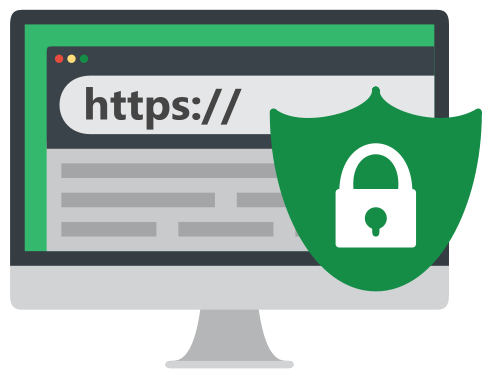
Wildcard certificate are an option that is popular with websites that want to secure multiple subdomains or domains. These certificates are simple to install and can help businesses save money when compared with individual SSL certificates. These certificates come with certain risks which need to be taken into consideration.
Risks of a Wildcard Certificate
Wildcard TLS certificates offer security to multiple domains or subdomains that are hosted on the same server. This is the best option for companies with multiple websites who need HTTPS. But it does have some significant security issues.
Wildcard certificate's biggest security threat is that all servers and subdomains are at risk if just one is compromised. It is possible to launch phishing campaigns against other subdomains using the same certificate if a single server or subdomain is compromised.
Moreover, in the event that the wildcard certificate was revoked, then all those subdomains had to be reissued a certificate. This could be a large amount of work that can result in significant downtime on the site or service.

This could lead to traffic redirections if the wildcard certificate's private key is compromised. It is an Application Layer Protocol Allowing Cross-Protocol Attack.
A malicious cyber actor that has network access can exploit this vulnerability to steal sensitive information, including passwords and credit card data. The NSA warns of this threat and suggests that organizations should not use wildcard TLS certificates in their infrastructure.
What is Wildcard Certification?
A wildcard certificate is a digital SSL/TLS certificate that provides security for all the subdomains associated with a specific domain. It's issued by a Certificate Authority. Most browsers and smartphones support it.
It is valid for an unlimited number of servers and can be reissued as many times as you like. This can be used to protect a large number domains and subdomains simultaneously.
They offer a more secure option than other methods of securing your website. They are easier to use and more reliable than multi-domain certificates. Also, they are compatible on more modern devices and browsers.

They are usually the best choice for organizations who need to protect multiple domains or subdomains simultaneously. These include organizations that have multiple subdomains such as blogs, forums, or shopping sites.
Wildcard certificates come in a variety of different forms. Each of them offers the same benefits but differs in pricing. Some CAs, such as VeriSign, will price wildcard certificates by the domain being protected, while others will price them based on the total number of domains they are protecting.
Wildcard certificates can be used by organizations to protect multiple subdomains or domains. To ensure the wildcard certificate is implemented in an organization's best interests, it is important to discuss its purpose with the security team.
FAQ
How much does it cost to create an ecommerce site?
This depends on your platform and whether you hire a freelancer or go through a service provider. eCommerce sites typically start at around $1,000.
Once you have chosen a platform, expect to pay between $500 and $10,000.
If you're planning on using a template, you probably won't pay more than $5,000. This includes any customizations you may need to match your brand.
What is a responsive web design?
Responsive Web Design (RWD) is an approach to designing websites where content displays responsively on all devices - desktop computers, laptops, tablets, smartphones, etc. This allows users to view a website on one device simultaneously but still access other features such as navigation menus, buttons, etc. RWD is designed to ensure that a user can view a site on any size screen.
A website that sells primarily through eCommerce would be an example of this. You want your customers to be able to purchase products from your store, even if they are viewing it on a phone.
A responsive site will adapt to the device used to view it. Your laptop will view the website exactly as a normal desktop site. But, the page will appear differently if you view it on your phone.
This means you can make a website that looks amazing on all types of devices.
How to design your website?
Understanding your customers' needs is the first step. What are they looking for when they visit your site?
What problem might they face if your site doesn't have what they are looking for?
Now you need to figure out how you can solve these problems. Also, you need to ensure that your website looks professional. It should be easy-to-use and navigate.
You should have a well-designed website. It shouldn't take too much time for it to load. People won't stay as long if it takes too long to load. They'll move elsewhere.
If you're going to build an eCommerce site, you need to think about where all your products are located. Are they all in the same place? Are they in one location?
You must decide whether to sell one product only or many products simultaneously. Do you prefer to sell one type of product, or several types?
When you answer these questions, your site can be built.
Now, it's time to take care of the technical aspects. How will your site work? Is it fast enough? Is it possible to access the information quickly using a computer?
Can people buy things without having to pay more? Will they have to register with your company before they can buy something?
These are important questions that you must ask yourself. You'll be able to move forward once you have the answers to these important questions.
Is WordPress a CMS?
The answer is yes. It's called a Content Management System. CMS allows you to manage the content of your website from within a web browser, instead of using applications like Dreamweaver and Frontpage.
WordPress is completely free! Hosting is included in the price, but you don't need to pay anything else.
WordPress was initially designed as a blogging platform but now offers many different options, including eCommerce sites, forums, membership websites, portfolios, etc.
WordPress is simple and easy to install. You must download the installation file from their website and upload it onto your server. You can then visit your domain name using your web browser to log in to your new website.
After installing WordPress on your computer, you'll need a username and a password. Once you log in you'll be able access all your settings via a dashboard.
From here, you can add pages, posts, images, links, menus, widgets, and plugins. If you are comfortable creating and editing content, you can skip this step.
If you prefer to work with a professional web designer, you can hire them to manage the entire process.
Are there any technical skills required to design and build my site?
No. All you need to understand HTML and CSS. You can easily find tutorials online that teach both HTML and CSS.
Statistics
- Is your web design optimized for mobile? Over 50% of internet users browse websites using a mobile device. (wix.com)
- Studies show that 77% of satisfied customers will recommend your business or service to a friend after having a positive experience. (wix.com)
- It's estimated that in 2022, over 2.14 billion people will purchase goods and services online. (wix.com)
- It's estimated that chatbots could reduce this by 30%. Gone are the days when chatbots were mere gimmicks – now, they're becoming ever more essential to customer-facing services. (websitebuilderexpert.com)
- In fact, according to Color Matters, a signature color can boost brand recognition by 80%. There's a lot of psychology behind people's perception of color, so it's important to understand how it's used with your industry. (websitebuilderexpert.com)
External Links
How To
What is website hosting?
Website hosting refers simply to the place that people visit when they visit a website. There are two types:
-
Shared hosting – This is the most affordable option. Your website files are stored on a server that is owned by another person. Your customers' requests travel via the Internet to your server when they visit your site. The owner of the server then hands off the request to you.
-
Dedicated hosting: This is the most costly option. Your website is located on only one server. No other websites share space on the server, so your traffic stays private.
Shared hosting is preferred by most businesses because it's cheaper than dedicated hosting. You can use shared hosting if the company owns the server to provide the resources required for your website.
However, both have their advantages and disadvantages. Here are some key differences between them.
Pros of Shared Hosting
-
Lower Cost
-
Simple to Setup
-
Frequent Updates
-
It is possible to find it on many web hosting companies
Hosting shared can be as low as $10 per month. Remember that shared hosting usually comes with bandwidth. Bandwidth is how much data you can transfer to the Internet. You may have to pay extra for large amounts of data, even if your blog only contains photos.
You will quickly see why you paid so much for your former host once you have started. Most shared hosts don't offer any customer support. Their techs will occasionally walk you through setting up your site, but you're on your own after that.
It is important to find a provider that provides 24-hour support. They will attend to any issues you have while you sleep.
Hosting dedicated:
-
More Expensive
-
Less Common
-
Specific Skills Required
You're getting everything you need with dedicated hosting to operate your website. You won't have to worry about whether you're using enough bandwidth or whether you've got enough RAM (random access memory).
This means you'll have to spend more upfront. But once your online business starts, you'll realize you don't need any technical assistance. You'll be able to manage your servers effectively.
Which Is Better For My Business:
The answer will depend on the type and purpose of your website. Shared hosting is best for those who only need to sell products. It is easy to set-up and manage. You'll probably receive frequent updates because you are sharing a server hosting many other sites.
However, dedicated hosting is the way to go if you want to build a community around your brand. You can focus on building your brand without worrying about handling your traffic.
If you're looking for a web host that offers both options, we recommend Bluehost.com. They offer unlimited monthly data transfers and 24/7 support. You can also register domain names for free.